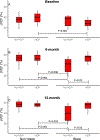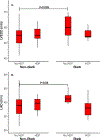Race, hypertensive disorders of pregnancy and outcomes in peripartum cardiomyopathy
- PMID: 38996860
- PMCID: PMC11437515
- DOI: 10.1016/j.ahj.2024.07.002
Race, hypertensive disorders of pregnancy and outcomes in peripartum cardiomyopathy
Abstract
Background: Black women with peripartum cardiomyopathy (PPCM) have a higher prevalence of hypertensive disorders of pregnancy (HDP) and worse clinical outcomes compared with non-Black women. We examined the impact of HDP on myocardial recovery in Black women with PPCM.
Methods: A total of 100 women were enrolled into the Investigation in Pregnancy Associated Cardiomyopathy (IPAC) study. Left ventricular ejection fraction (LVEF) was assessed by echocardiography at entry, 6, and 12-months post-partum (PP). Women were followed for 12 months postpartum and outcomes including persistent cardiomyopathy (LVEF ≤35%), left ventricular assist device, (LVAD), cardiac transplantation, or death were examined in subsets based on race and the presence of HDP.
Results: Black women with HDP were more likely to present earlier compared to Black women without HDP (days PP HDP: 34 ± 21 vs 54 ± 27 days, P = .03). There was no difference in LVEF at study entry for Black women based on HDP, but better recovery with HDP at 6 (HDP: 52 ± 11% vs no HDP: 40 ± 14%, P = .03) and 12-months (HDP:53 ± 10% vs no HDP:40 ± 16%, P = .02). At 12-months, Black women overall had a lower LVEF than non-Black women (P < .001), driven by less recovery in Black women without HDP compared to non-Black women (P < .001). In contrast, Black women with HDP had a similar LVEF at 12 months compared to non-Black women (P = .56).
Conclusions: In women with PPCM, poorer outcomes evident in Black women were driven by women without a history of HDP. In Black women, a history of HDP was associated with earlier presentation and recovery which was comparable to non-Black women.
Copyright © 2024 Elsevier Inc. All rights reserved.
Conflict of interest statement
Conflict of interest AEJ has received honoraria from Sanofi and Edwards Lifesciences. All other authors have no Conflicts of Interest to disclose.
Figures




References
-
- Arany Z, Elkayam U. Peripartum cardiomyopathy. Circulation 2016;133:1397–1409. - PubMed
-
- Gunderson EP, Croen LA, Chiang V, Yoshida CK, Walton D, Go AS. Epidemiology of peripartum cardiomyopathy: incidence, predictors, and outcomes. Obstetrics & Gynecology 2011;118:583–591. - PubMed
-
- Umesawa M, Kobashi G. Epidemiology of hypertensive disorders in pregnancy: prevalence, risk factors, predictors and prognosis. Hypertens Res 2017;40:213–220. - PubMed
MeSH terms
Grants and funding
LinkOut - more resources
Full Text Sources
Medical
Miscellaneous

